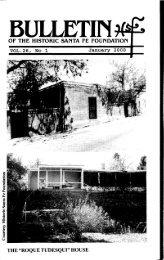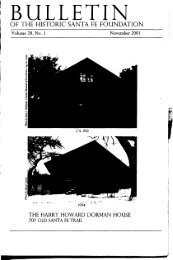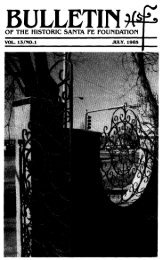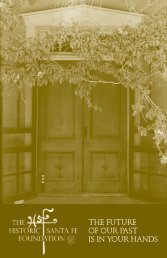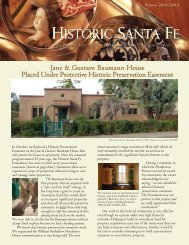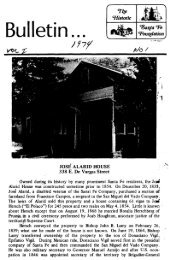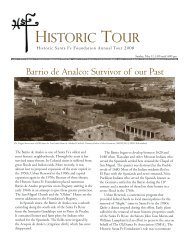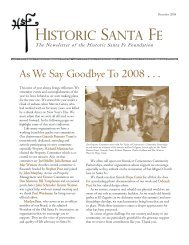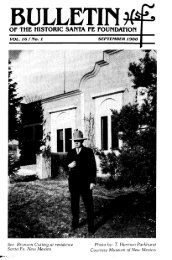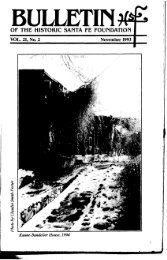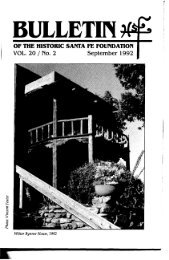James L. Johnson House - Historic Santa Fe Foundation
James L. Johnson House - Historic Santa Fe Foundation
James L. Johnson House - Historic Santa Fe Foundation
You also want an ePaper? Increase the reach of your titles
YUMPU automatically turns print PDFs into web optimized ePapers that Google loves.
the Catron Block is today. By the<br />
1870s <strong>James</strong> <strong>Johnson</strong> was one of<br />
the region's most successful merchants.<br />
He had extensive land<br />
holdings around <strong>Santa</strong> <strong>Fe</strong> and<br />
throughout the territory and was<br />
involved in most of the important<br />
business activities of the<br />
day-wholesale and retail trade,<br />
real estate, banking, and mining.<br />
However, in 1881 he suffered a<br />
major reversal of fortune, possiblythe<br />
resuh of new credit realities<br />
which came with the railroad.<br />
With his wife, Maria Jesus<br />
(Jesusita) Montoya of Chihuahua,<br />
Mexico, <strong>Johnson</strong> raised a<br />
family of seven children at their<br />
Canyon Road home. Beginning<br />
in 1854, the year before joining<br />
<strong>James</strong> L. <strong>Johnson</strong>,<br />
Beck's firm, <strong>Johnson</strong> purchased<br />
Courtsy Museum o/New Mexico No.165641 several parcels of land on the<br />
north side of Canyon Road, an<br />
ancient trail up the <strong>Santa</strong> <strong>Fe</strong> River Canyon. He chose a location that was<br />
somewhat removed from the Plaza, the main center of activity. It was a<br />
sparsely populated area amid fields cuhivated by Spanish families, as it<br />
had been one hundred years earlier when the Urrutia Map (c. 1766) was<br />
drawn. <strong>Johnson</strong>'s first tract, purchased from Juan Bautista Moya, contained<br />
a house of an unspecified number of rooms and a corral. He enlarged this<br />
property with additional purchases in 1857, 1864, and 1875 and buih a<br />
sizable Territorial-style home for his growing family, probably incorporating<br />
existing rooms. He eventually owned a large tract opposite on the south<br />
side of Canyon Road, which contained orchards, stables and outbuildings.<br />
As a result of the 1881 financial crisis, <strong>Johnson</strong> lost his home and all the<br />
Canyon Road property, his business block on the Plaza, and other significant<br />
properties to Thomas B. Catron, the powerful <strong>Santa</strong> <strong>Fe</strong> lawyer and<br />
politician. The business was never recouped and members of the family<br />
lived on Canyon Road as Catron's tenants into the twentieth century. In<br />
<strong>Johnson</strong>'s later years, the family formed a friendship with Adolph Bandelier,



